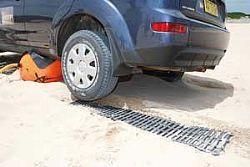It’s a fact of life that more and more people are swapping their “tough trucks” for what we like to call “recreational” 4WDs – also known as “softroaders” or SUVs – 4WDs without low ratio. In fact our Giant Test starting on page 22 looks at a number of these. One of the main reasons for the switch is that these vehicles are less expensive than the more complex 4WDs with low ratio – and because they are lighter, they are usually more fuel efficient and easier to drive. At the same time the technology, capacity and versatility of the recreational 4WD is improving all the time. As you’ll see in our report, some of these vehicles are quite able to get into backwoods areas and perform relatively well, although there will always be those occasions when a “tough truck” can go further. However, if you are planning to go on a 4WD excursion in your recreational 4WD, it’s important you understand your vehicle’s limits and that you have the right equipment to ensure you’re not stranded! For a relatively low investment an SUV owner can equip the vehicle to tackle marginal conditions such as sand dunes, mud holes and areas of low grip so they can visit remote areas with a minimum of fuss. Here’s a check list: • Vehicle preparation • Tyres – standard tyres fitted to most SUVs don’t give the grip, or the sidewall strength, required for off-road work. At least all-terrain tyres should be fitted. • Suspension - in some cases, a minor change to ride height can make travelling more comfortable and reduce the potential for undercarriage damage. • Recovery hitch - most of the recovery points fitted on modern SUVs are not strong enough to withstand a heavy recovery, such as a snatch, and should be replaced with stronger aftermarket items. • Floor mats and wagon liner to protect the inside floor surfaces from damage and dirt. • Load barrier to prevent cargo and off-road gear from being thrown around the vehicle, causing injury in a crash or sudden braking situation. • Containers for both extra fuel and water to ensure if you are stuck there are adequate supplies to survive an emergency. • First aid kit. Your recovery kit should include the following: • A good quality snatch strap. • At least two bow shackles. • Tree protector. • Snig chain. • A hand winch, or at least an exhaust jack or sand tracks/ladders. • A quality compressor and tyre gauge. • A good spade. • A machete. The compressor and tyre gauge are so you can let the air out of your tyres when venturing off the beaten track. Not only does this give a more comfortable ride, but also ensures more grip in low-grip conditions such as sand or mud. To use the snatch strap you need another vehicle, so don’t travel alone if you can help it. Make sure you know how to use it before you go, and keep everyone well clear while you’re attempting the snatch – if anything breaks the strap, or the shackles – or whatever has broken – can be lethal. Similarly with the hand winch. Make sure the wire rope is properly attached to your vehicle and the solid object you’re winching against (usually this will be a tree) and NEVER step over the rope when it’s under tension. As we mentioned earlier, the most important thing is to find out the limitations of your vehicle BEFORE you go on a trip into the wilds. That way you’re less likely to need the recovery kit in the first place!
Taking your SUV off-road
Monday, 15 December 2008




